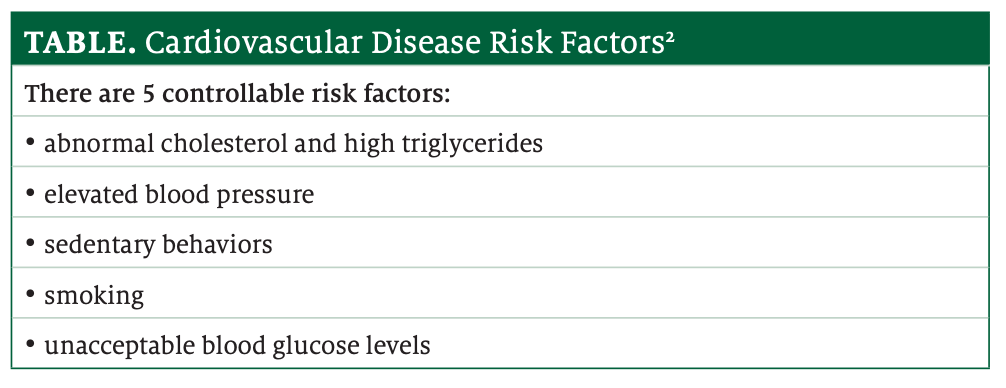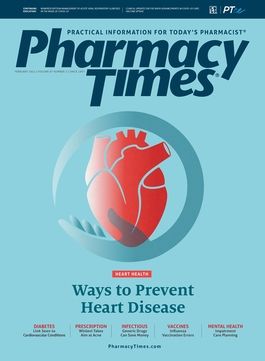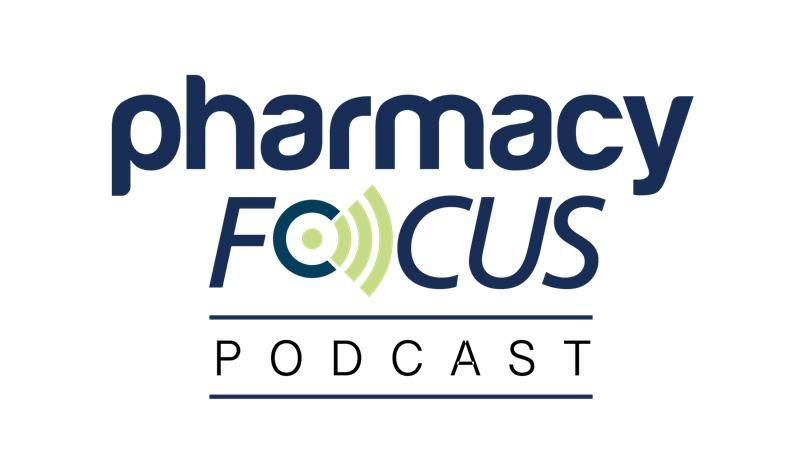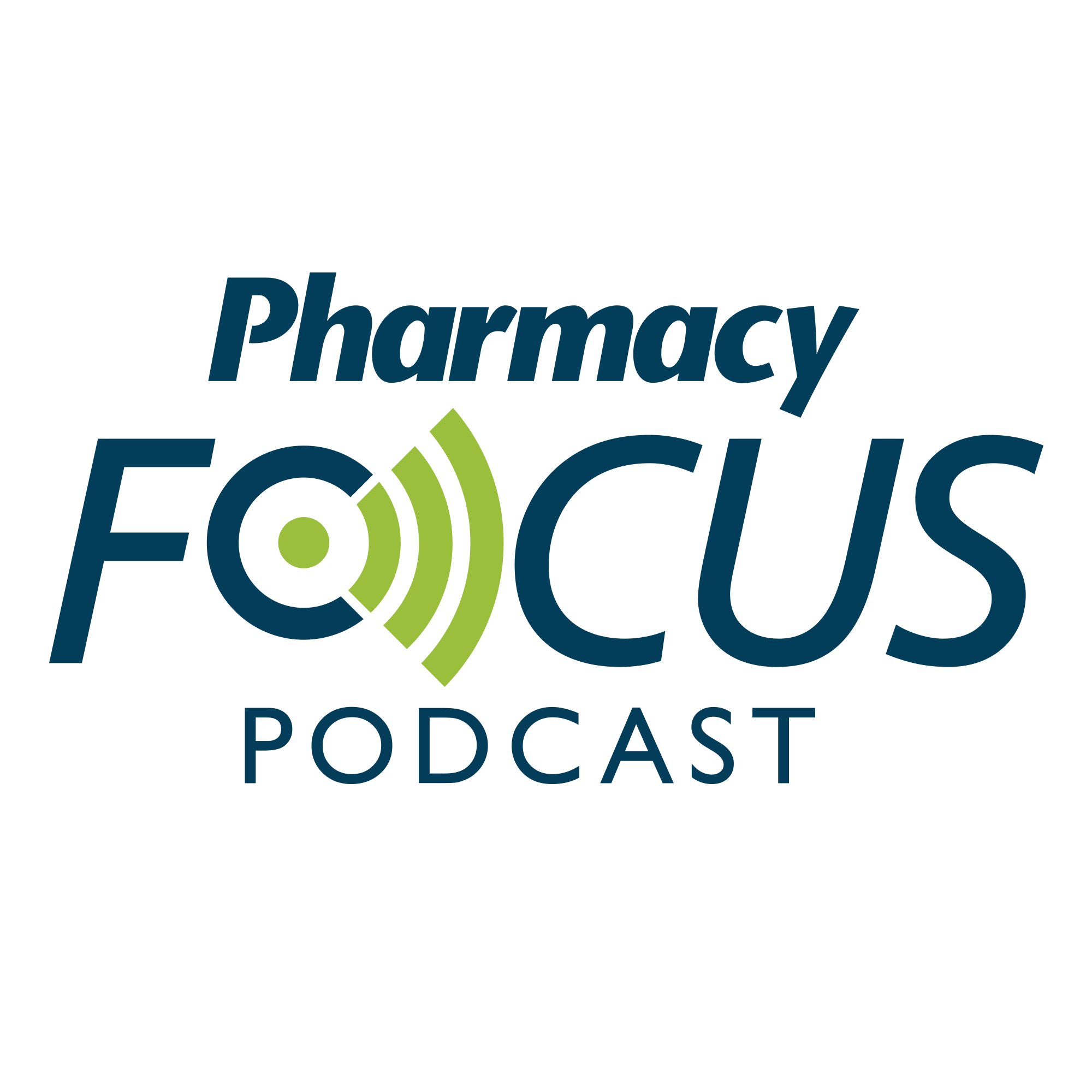Publication
Article
Pharmacy Times
CVD and T2D Are Companion Concerns
Author(s):
Patients with diabetes have a higher risk of cardiovascular disease and heart failure.
The American Heart Association indicates that a diagnosis of type 2 diabetes (T2D) doubles the risk of developing cardiovascular disease (CVD).1 Although past research suggested that people with T2D who controlled CVD risk factors well had little excess risk of CVD events or death, new data indicate that may not be the case.2
A study that randomized more than 101,000 people found that even when 5 factors (see TABLE2) were optimally controlled, patients with T2D had a 21% higher risk of CVD and a 31% higher risk of heart failure (HF) hospitalization than patients without diabetes.2 Just 6% of participants with T2D had all measured risk factors within target range.2 The FDA, recognizing that CVD and diabetes often co-occur, has made a point of evaluating evidence for the safety of antidiabetic therapies with respect to CVD, especially in patients who have preexisting CVD.3-5

The American Heart Association considers 2 additional risk factors that are controllable: diabetes and obesity.
For patients with T2D, risk increases with diabetes duration. As the number of CV safety trials in patients with T2D and preexisting CVD has increased, some hypoglycemic medications have shown unique abilities in secondary prevention of CVD and related outcomes.
DPP-4 INHIBITORS
Dipeptidyl peptidase 4 (DPP-4) inhibitors prevent the breakdown of glucagon-like peptide 1’s (GLP-1) breakdown, prolonging its activity. They affect other incretins similarly.6 DPP-4 inhibitors reduce glycated hemoglobin A1C modestly without causing hypoglycemia or weight gain in patients.6 Findings from studies of DPP-4 inhibitors, such as alogliptin, saxagliptin, and sitagliptin, indicate that they do not increase CV adverse events (AEs) or all-cause or CV mortality, but do not create a measurable CV benefit.7-9 In 2015, the FDA issued a safety warning indicating that alogliptin and saxagliptin may increase the risk of HF in patients with preexisting HF.10
DPP-4 inhibitors’ most common AEs are headache, heart failure, hypersensitivity, nasopharyngitis, and skin reactions. They may contribute to hypoglycemia. They may also cause joint pain that can be disabling and severe.11
SGLT2 INHIBITORS
Sodium-glucose cotransporter-2 (SGLT2) inhibitors are responsible for glucose reabsorption in the proximal renal tubules. SGLT2 inhibitors are orally administered, and their diuretic effect reduces sodium and increases water loss to promote weight loss and reduce blood pressure.12 Early studies indicated that patients treated with empagliflozin had significantly lower CV death rates than matched controls, though rates of myocardial infarction and stroke were similar. Of note, empagliflozin reduced HF admissions by 35%. Empagliflozin’s beneficial CV effects appeared earlier than those associated with GLP-1 analogues, suggesting a mechanism of action related to a prominent hemodynamic rather than an antiatherosclerotic cause.12 Subsequent studies in SGLT2 inhibitors have been positive, with canagliflozin also associated with less HF.13 Ertugliflozin also reduces risk of CV death and hospitalization with HF.14 SGLT2 inhibitors also slow the progression of kidney disease, a key cause of progressive morbidity and mortality in diabetes, and delay dialysis.15,16
Superficial genital mycotic infections, especially in women and uncircumcised men, are common with SGLT2 inhibitors. Risk of urinary tract infection is elevated, as is rare euglycemic diabetic ketoacidosis.
They have been associated with hypoglycemia. The FDA warns against using canagliflozin in patients at higher risk of amputations.17 Patients treated with SGLT2 inhibitors also need adequate kidney function.
GLP-1 ANALOGUES
The injectable GLP-1 analogues activate endogenous GLP-1 receptors. They delay gastric emptying, inhibit glucagon secretion, and promote glucose-dependent insulin release.18 Effects such as improved hypertension, less hypoglycemia, and weight reduction may contribute to improved CV outcomes.19
Published trial results suggest that GLP-1 analogues’ benefits may not be a class effect, and each drug’s FDA-approved indication reflects the differences. Exenatide and exenatide ER do not carry a CV event reduction indication. Dulaglutide, liraglutide, and semaglutide do. Liraglutide and semaglutide have no significant effect on HF, suggesting a different mechanism of action than SGLT2 inhibitors (possibly an antiatherothrombotic effect).
Gastrointestinal AEs, such as abdominal pain, constipation, diarrhea, nausea, and vomiting, are the most common with GLP-1 agonists. This class of drugs carries a boxed warning that they have caused thyroid C-cell tumors in rats, and advises avoiding use in patients with a family or personal history of medullary thyroid carcinoma or multiple endocrine neoplasia syndrome type 2.18,19
BOTTOM LINE
Choice of hypoglycemic medication often requires discussion between patients and their prescribers. Many patients may prefer oral drugs, making the SGLT2 inhibitors attractive. SGLT2 inhibitors are also preferable for patients at increased risk of HF. For those already using injectable insulin or insulin analogues, the injectables may be less of a concern. Classes associated with weight loss can be helpful for patients dealing with obesity.
JEANNETTE Y. WICK, RPH, MBA, FASCP, is the assistant director of the Office of Pharmacy Professional Development at the University of Connecticut School of Pharmacy in Storrs.
REFERENCES
- Cardiovascular disease and diabetes. American Heart Association. Updated August 30, 2015. Accessed December 27, 2020. https://www.heart.org/en/health-topics/diabetes/why-diabetes-matters/cardiovascular-disease--diabetes#.WllX1ZM-fBJ
- Preventing heart disease should be a priority for people with type 2 diabetes. News release. American Heart Association. November 16, 2020. Accessed December 27, 2020.https://newsroom.heart.org/news/preventing-heart-disease-should-be-a-priority-for-people-with-type-2-diabetes
- Guidance for industry: diabetes mellitus—evaluating cardiovascular risk in new antidiabetic therapies to treat type 2 diabetes. FDA. December 2008. Accessed December 27, 2020. https://www.fda.gov/media/71297/download
- Guideline on clinical investigation of medicinal products in the treatment or prevention of diabetes mellitus. European Medicines Agency. January 29, 2018. Accessed December 27, 2020.https://www.ema.europa.eu/en/documents/scientific-guideline/draft-guideline-clinical-investigation-medicinal-products-treatment-prevention-diabetes-mellitus_en.pdf
- HiattWR, Kaul S, Smith RJ. The cardiovascular safety of diabetes drugs—insights from the rosiglitazone experience. N Engl J Med.2013;369(14):1285-1287. doi:10.1056/NEJMp1309610
- Zhong J, MaiseyeuA, Davis SN, Rajagopalan S. DPP4 in cardiometabolic disease: recent insights from the laboratory and clinical trials of DPP4 inhibition. Circ Res. 2015;116(8):1491-1504. doi:10.1161/CIRCRESAHA.116.305665
- Scirica BM, Bhatt DL, Braunwald E; SAVOR-TIMI 53Steering Committee and Investigators. Saxagliptin and cardiovascular outcomes in patients with type 2 diabetes mellitus. N Engl J Med. 2013;369(14):1317-1326. doi:10.1056/NEJMoa1307684
- White WB, Cannon CP, Heller SR; EXAMINE Investigators. Alogliptin after acute coronary syndrome in patients with type 2 diabetes. N Engl J Med. 2013;369(14):1327-1335. doi:10.1056/NEJMoa1305889
- Green JB, Bethel MA, Armstrong PW; TECOS Study Group. Effect of sitagliptin on cardiovascular outcomes in type 2 diabetes. N Engl J Med. 2015;373(3):232-242. doi:10.1056/NEJMoa1501352
- FDA drug safety communication: FDA adds warnings about heart failure risk to labels of type 2 diabetes medicines containing saxagliptin and alogliptin. FDA. February 11, 2014. Updated April 5, 2016. Accessed December 27, 2020. https://www.fda.gov/downloads/Drugs/DrugSafety/UCM493965.pdf
- FDA drug safety communication: FDA warns that DPP-4 inhibitors for type 2 diabetes may cause severe joint pain. FDA. August 28, 2015. Accessed December 27, 2020.https://www.fda.gov/media/93280/download
- Abdul-Ghani MA, Norton L, Defronzo RA. Role of sodium-glucose cotransporter 2 (SGLT 2) inhibitors in the treatment of type 2 diabetes. EndocrRev. 2011;32(4):515-531. doi:10.1210/er.2010-0029
- Neal B, Perkovic V, Mahaffey KW; CANVAS Program Collaborative Group. Canagliflozin and cardiovascular and renal events in type 2 diabetes. N Engl J Med.2017;377(7):644-657. doi:10.1056/NEJMoa1611925
- Cosentino F, Cannon CP, Cherney DZI; VERTIS CV Investigators. Efficacy of ertugliflozin on heart failure-related events in patients with type 2 diabetes mellitus and established Commented [RP6]: Checked linkCommented [RP7]: Checked linkatherosclerotic cardiovascular disease: results of the VERTIS CV trial. Circulation.2020;142(23):2205-2215. doi:10.1161/CIRCULATIONAHA.120.050255
- Empagliflozin outcome trial in patients with chronic heart failure with reduced ejection fraction (EMPEROR-Reduced). ClinicalTrials.gov. February 20, 2017. Updated August 11, 2020. Accessed December 27, 2020.https://clinicaltrials.gov/ct2/show/NCT03057977
- Wanner C, Inzucchi SE, Lachin JM; EMPA-REG OUTCOME Investigators. Empagliflozin and progression of kidney disease in type 2 diabetes. N Engl J Med.2016;375(4):323-334. doi:10.1056/NEJMoa1515920
- FDA drug safety communication: FDA confirms increased risk of leg and foot amputations with the diabetes medicine canagliflozin (Invokana, Invokamet, Invokamet XR). News release. FDA. Updated August 26, 2020. Accessed December 27, 2020. https://www.fda.gov/Drugs/DrugSafety/ucm557507.htm
- Gupta A, Jelinek HF, Al-AubaidyH. Glucagon like peptide-1 and its receptor agonists: their roles in management of type 2 diabetes mellitus. Diabetes Metab Syndr.2017;11(3):225-230. doi:10.1016/j.dsx.2016.09.003
- Sattar N, Petrie MC, Zinman B, Januzzi JL Jr. Novel diabetes drugs and the cardiovascular specialist. J Am Coll Cardiol.2017;69(21):2646-2656. doi:10.1016/j.jacc.2017.04.014

Newsletter
Stay informed on drug updates, treatment guidelines, and pharmacy practice trends—subscribe to Pharmacy Times for weekly clinical insights.






